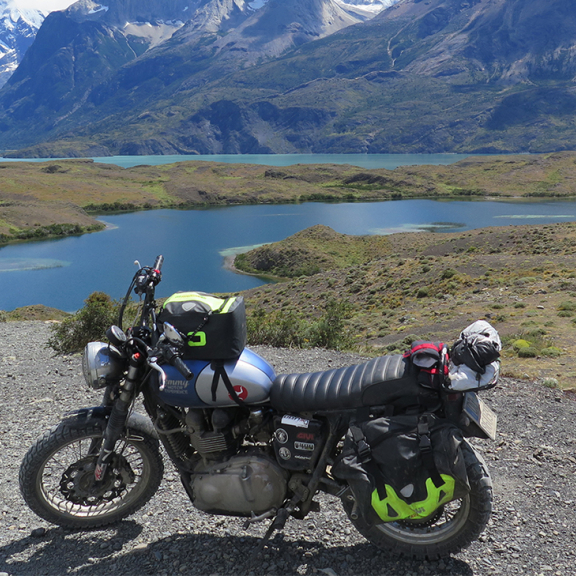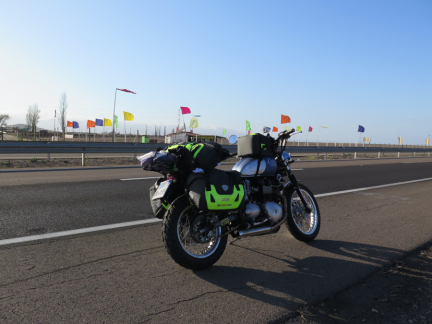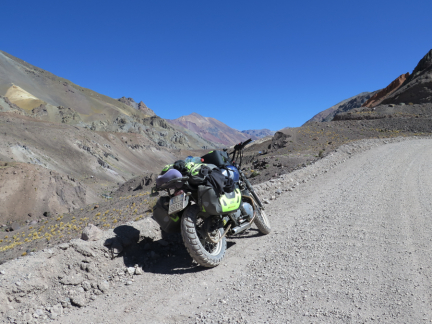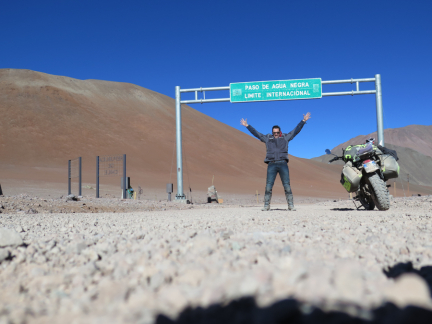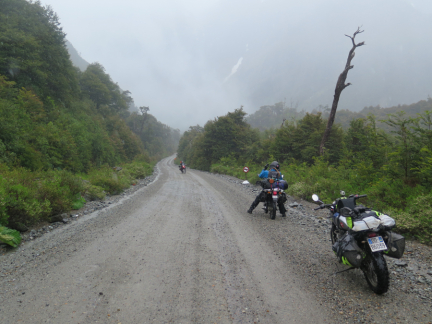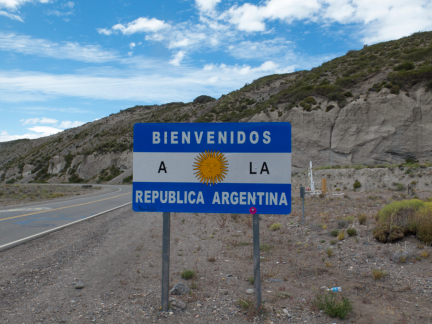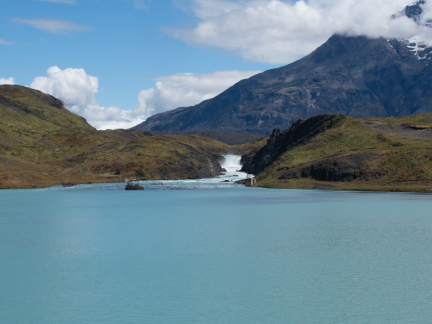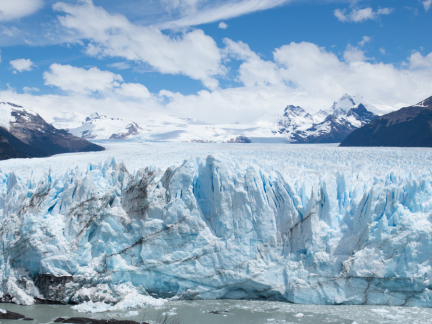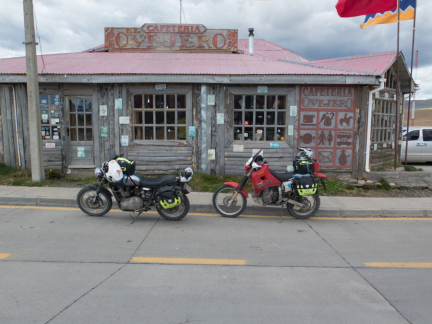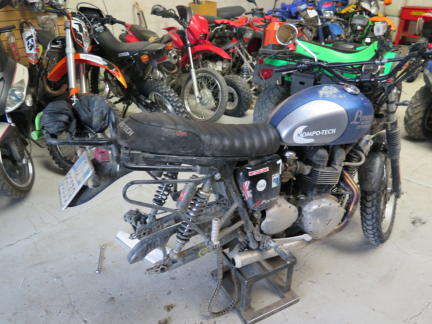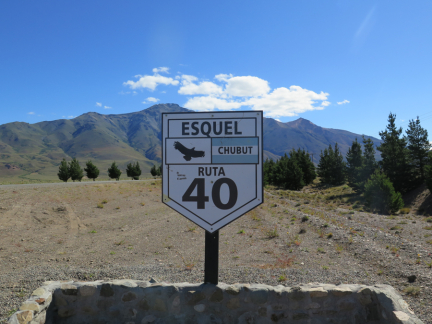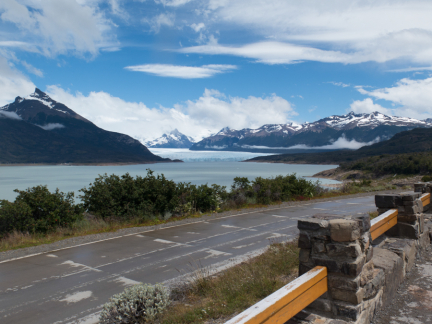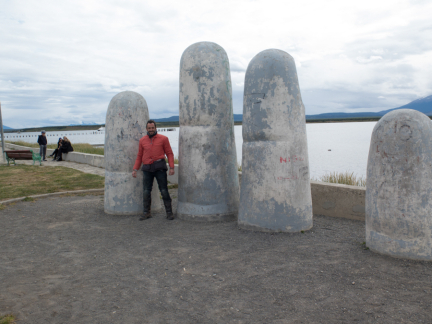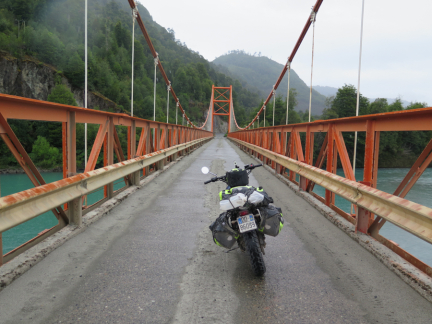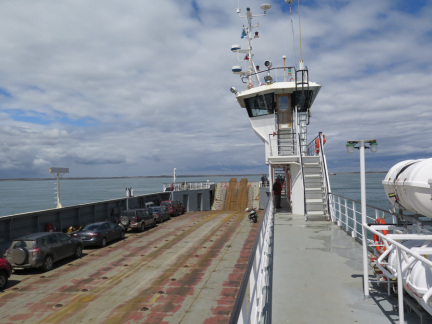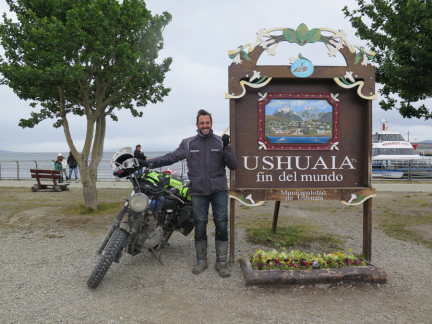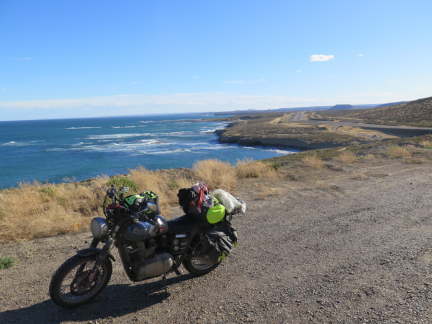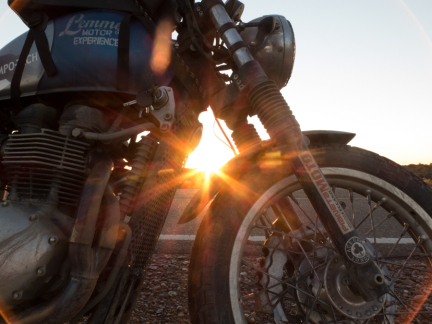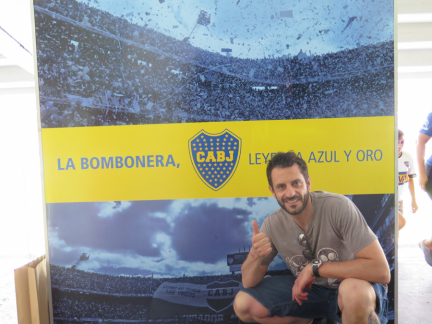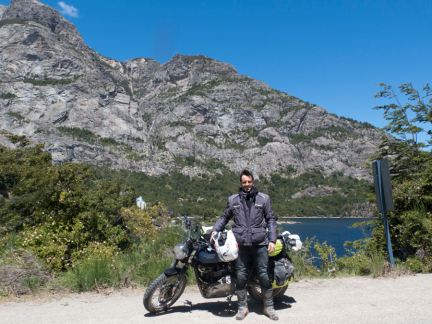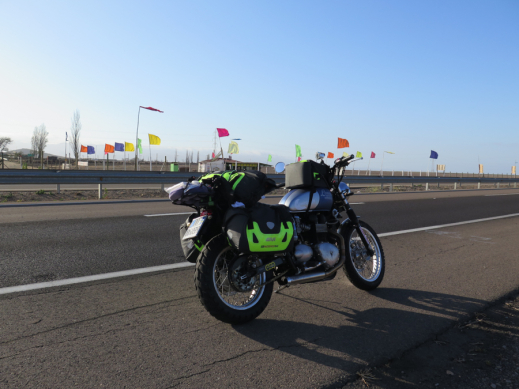South America
Motorcycle travel in South America
Ruta hacia el fin del mundo is born of the splendour of the air, sand and stars, the desire to travel of 6 guys who, once back from a raid in the Tunisian desert, decided to reach the Fin del Mundo. The idea was to set off from Bolivia, passing through Peru and Chile, crossing Argentina and ending up in the far south, in Ushuaia.
The means of transport was a given: a motorbike. But not just any motorbike, not a motorbike without a soul, to hire and squeeze as many kilometres as possible out of, but instead my own bike – a Triumph Bonneville. A bike unsuitable for getting to the Island of Man to view the Tourist Trophy and definitely unsuitable for riding on dirt roads and crossing 4 metre-high dunes in the Tunisian Sahara; it would also be unsuitable for travelling 10,000 km up and down South America, through the endless Patagonian stretches, between the paved and unpaved (rìpio) roads of Route 40, until the most populated southern point on the planet. The dream of travelling along the roads of South America together vanished over time: for various reasons all the participants gave up on the plan, except for me. Driven by unshakeable and very personal motivations, I decide to leave on my own, modifying the route, but not without uncertainties and worries of various kinds. There is no time to think, I have to focus on organising the shipping of my bike, organising documents, luggage and all the other tricky logistics. The shipping process is quite complicated but in the end I manage to find a serious shipping company (Cuttica and Mr Elmo, author’s note) and in a short time my bike is on a flight headed to Santiago de Chile.
My departure is set for December 16th. More than 12 hours of flights and layovers, and finally I make it to Santiago, where I am picked up by Juan Carlos Salinas the despaciantes, who will help me get my bike through customs in record time. At sunrise on December 18th everything is in place to set off, after a quick check of my bike in the Triumph dealership of Santiago, which I miraculously find without a map or any other help; I will buy a road map a few days later, the GPS I left behind in Ceccano. All the fears and anxieties disappear as I move into first gear: now I’m off for real! On the first day, I ease into the stretch from Santiago to La Serena, travelling around 500km towards north on solid, tarmac roads, hoping to nurture an affinity between the pilot and the bike, although already a strong bond exists: every adventure has its own story, and this one is still just at the beginning. Straight after leaving Santiago the scenery is captivating, with rocky mountain ranges towering over the roads; halfway onwards however, the road runs close to the sea and the wind violently lashes out at the Pacific Ocean highlighting the real beauty of the coast. By the evening I arrive in La Serena, a well-known seaside spot famous also for being the second oldest city in Chile: the following day will be the real ‘baptism’ of the journey.
On the second day I intend to do around 350km, 250 of which are on rìpio (dirt roads), with a maximum altitude of 4779m at Paso de Agua Negra: it’s the leg of the trip which really catapults us into my journey. The trip begins well with an easy ride on well-paved roads and then I hit the complicated, dirt ones: complicated due to the soft roadbed and due to the presence of road workers, working on building a new route. Once past the Chilean customs there is almost no one on the roads; even though the pass is the only border crossing in that area, it isn’t very busy partly because of how dangerous it is. For riding on it, there is only one rule: open the throttle! The experience in the Tunisian desert has been fundamental. The road is pleasantly smooth, with the new tyres, the bike is ok and the rider is full of enthusiasm, all these things make the dirt road a unique riding experience also because of the landscape and its variable colours. Not only rusty, sulphur and pastel green mountains, but also bodies of water and lakes of primordial beauty; it’s a magical place that doesn’t welcome tourists but that lets them pass through giving the travellers’ eyes a unique treat, of an arid nature, but that is in its own way alive.
At the 3,000m mark the wind gets stronger and there are more and more drops that are quite high and terrifying, without any form of protection on the exposed side. The road continues to climb, higher and higher, and I worry about taking the wrong turning or being overcome by the lack of oxygen; luckily the only symptoms caused by the high altitude are mostly just a sensation of general heaviness. Arriving at the 4000m mark, my head begins to feel very heavy and my bike seems less responsive; without ever thinking of giving up, I can’t resist taking a few photos of the marvellous penitentes, melting snow banks on the edge of the road that take the forms of roving monks. The 4,700m mark feels as if it is out of reach, also because the road signs are few and far between, and the road, if you can even call it one at this point, is much more difficult; being seldom traversed leaves it softer and since there is little traffic no one has thought to invest in improving it. Once we finally reach the 4,700m mark, the Paso de Agua Negra is before me. Arid and bare of every useless embellishment, fascinating and magical. The wind is cold and very strong, the sun is shining but not enough to warm me up: it’s a once in a lifetime experience; maybe it’s the short supply of oxygen or the solitude, but the emotions brought forward by these moments are unique.
The descent is slow and easy, I enjoy this small victory and pat the tank to thank it and unload the built up tension. The rest of the route is along docile, winding roads and descending means more oxygen and higher temperatures. A quick visit in customs and I’m in Pismanta, in Argentina. The following morning I head down south and finally find Ruta 40 that will keep me company for many a kilometre. The road is pavimentada (paved) and initially offers a winding stretch with decent tarmac but dirtied by debris fallen from the rocky walls; once past the mountains the landscape becomes arid, steppe-like and the road is straight, but not infinitely so. Mendoza is the first big city; as if to taunt the desert which surrounds it, its vegetation is lush and green. Many tell me that it’s dangerous and as testimony to this I see all the fences, that look like they could be protecting bunkers, of the houses along the road; it takes a long time to find a small hotel with an internal protected car park: I absolutely cannot risk being without my trusty steed.
Leaving Mendoza, over the following days, the mantra is always the same: few curves, infinite straight stretches of road, arid scenery, I calculate approximately how many kilometres there are between one petrol station and the next, with fluctuating temperatures and a fast and reliable bike. To all this is added an element that will stay by my side until I reach Ushuaia: the wind. In this area it howls constantly and since there are no ‘obstacles’ it is free to whip and lash anything it comes across; we are still far from the powerful winds of the south but I begin to familiarise myself with the elements and to understand how to behave so as to have a firm grip of my bike. Before arriving in San Carlos Bariloche I ride along Camino de los siete lagos, a road that crosses seven lakes from San Martin del los Andes until Villa la Angostura; good asphalt, magnificent bends and scenery of rare beauty. We’re already in Patagonia, in the region of the lakes and here nature puts its best face forwards; I won’t see other vegetation quite so lush and colourful for the rest of the trip, an explosion of flora of every kind immersed between the jagged mountains and the blue, blue lakes.
San Carlos Bariloche is a graceful spot renowned for its ski resorts. Bariloche, despite being graceful, is quite touristy and not exactly in line with what moves me, but I will retain the beautiful memory of its landscapes, both right before entering the city and once leaving, where there are about 40km of winding roads surrounded by such lush vegetation and sparkling blue lakes. I spend Christmas between Chile and Argentina passing through the Futaleufù pass, with another 200km of dirt roads in parks and mountains at about 1000m. Witnessing the way in which Chile respects and protects the environment is incredible: like a true rough biker, covered in dirt with a noisy bike and with my baggage arranged like that of a smuggler, at customs I am reprimanded for not having declared having a jar of honey on me (it is strictly forbidden to bring any type of fresh alimentary product into Chile).
A Christmas day all but relaxing, the first kilometres fly by without any particular difficulty, the bike by this point accustomed to the dirt roads proceeds sure of itself; once having crossed the area dedicated to rafting, Holy Christmas begins. It starts to pour down and the road turns to sludge, peppered with sharp stones. I’m now on Ruta Nacional 7, the Carrettera Austral, still in the process of being modernised: actually this stretch looks like it’s just been built, the river on one side, the mountains on the other, occasionally presenting me with the gift of some stones. Many kilometres are full of a mess of signs, potholes, poles and equipment just dumped there for the Christmas holidays, before arriving in Puyuhapi a small inhabited town south of Puerto Monnt. Here I meet Michael and Hugo, two guys from Bruxelles that are doing the same route as me on two Chinese bikes (Motomel, 250cc,single cylinder, author’s note); we decide to set off together the following morning.
On the morning of the 26th, the weather hasn’t improved at all. We head towards Coyaique and straight away the riding conditions worsen. That stretch of Ruta 7 is under construction, full of mud, stones and potholes and the visibility is reduced because of the dirt that continues to stick to our visors: even the day of the 26th proves to be long and difficult. We’re back on tarmac with two broken back spokes, and considering the riding conditions, I try to find a way to change them. Coyaique is a very large city; I’m able to find a litre of oil, but no one is able to change the spokes; I start to worry seeing as I’m going to have to face further arduous roads. At the moment, I can’t do anything besides blocking them with two bands trying not to cause any damage to the nipples, which means having to assemble the air chambers and, if anything should go wrong in the middle of nowhere, it would be a big problem. We take a look around the city, grab dinner, a few artisanal Patagonian beers and the next morning we say our goodbyes.
El Calafate is the next destination; we set off leisurely, without any worries about the upcoming 300km of which 70 will be ripìo (dirt roads), it’s a stretch that should be easy and relaxing. However, it was anything but simple, the Ruta 40 is unassuming until we hit the ripìo: until today the dirt roads have been demanding, but doable, but things change drastically over the following 70km. Once started, I realise that to stay upright a superhuman strength is necessary. The rule of hitting the gas is still valid, but in this case it’s imperative to show caution: the mud and the dry earth mix to form a solid mass that sticks to everything, to the point of obstructing the front wheels from turning. To fix this inconvenience I’ll have to detach the front mudguard. This stretch of ripìo is also the stage for a fall due to the mud: nothing serious for me nor for my bike, only a few bruises and a bit of a scare seeing that it happens in the middle of nowhere. Sooner or later, I knew that Ruta 40 would christen me.
El Calafate is a big city on the edge of a glacier, I arrive with four broken spokes and so the priority is to find a mechanic and change them; I learn that once you break the first one, others will soon follow suit. I find a mechanic that gives me an appointment in the afternoon, and then make the most of my free time by visiting the most spectacular sight of the area: the Perito Moreno glacier. The first glance is unforgettable: I’m left breathless once I see from afar the grandeur of the glacier, and on a closer look I see just how majestic nature can be. Palaces of glaciers 40-50m high that suddenly break off into the waters of Lake Argentino with a powerful racket; then all of a sudden – calm is restored, accompanied by the continuous creak of the glacier, never stable, until other cracks open in the white mass and more chunks break off into the icy waters of Lake Argentino. It’s a feast for the senses that makes you stand still on the boardwalks in front of a wall of ice, admiring the size, listening for the static movements and almost smelling the cold. The rest of the day is spent at the mechanic’s waiting for them to change the damaged spokes, which in the meantime have become five; an excellent job without the need of using the air chamber.
The next day I’m back on the road heading towards the border of Chile, Rio Turbìo and then Puerto Natales. Around Rio Turbìo I get off Ruta 40; I now understand the meaning of ‘infinite’. From now on, I will think of this magnificent road that seems to go in every direction: a perfect straight line that never starts and never ends. I say goodbye to the long road that cuts Argentina in half from north to south, and set off towards the border in the direction of Puerto Natales. I stay in a hostel and plan a visit to Parco Naturale Torres del Paine for the following day; the km necessary to visit the whole natural park are too many to do without stopping at a petrol station, so I’m forced to fill up a plastic bottle with 10 litres, squeezed into one of my side bags. You can visit the park by following an internal itinerary between 50 to 100km; the road is unpaved, but it’s something you don’t even notice when you are admiring a beauty of such large dimensions, made of colourful lakes, pristine torrents, small waterfalls and majestic mountains (Cerro Castillo and Cuerno del Paine being the highest).
Re-entering Puerto Natales I head towards Punta Arenas, la fin del mundo is very close, I’m now in the region of Magellano and road signs start popping up singing the praises of the far south. The 250km seem easy but the climatic conditions worsen drastically. It’s much colder and the wind gets stronger and stronger, I ride with my bike lashed by the wind and inclined to the side, going at a steady pace, but each time I pass a truck I have to hold on tightly to the handlebars and keep my head low so as not to be violently tossed off my bike by a strong gust of wind. I find a modest hotel in Punta Arenas and look for a place to eat dinner and celebrate the end of the year. A breakfast of orange juice, nimesulide and a couple of stale biscuits, give me the boost I need to get back on the road and head in the direction of the strait of Magellano, to finally enter Tierra del Fuego. Getting all the way here, on board the only bike that I ever wanted, fills me with pride, and into the sea sink all those incidents that I leave behind me, the endeavour is almost over. I arrive in Rio Grande in the late afternoon, I could have ridden the remaining 200km to reach Ushuaia in the early evening, but the weather is working against me, as is time, and so I decide to wait.
In the morning, I get ready doing all the activities to load the bike, which by now have become a ritual, but I do them with greater care and more slowly, to savour once more that desire to reach Ushuaia; desire that will vanish once I’ve reached my destination. The leitmotif doesn’t change: strong wind, cold and torrential rain, after the first 100kms I stop to fill up. The rain stops for a little but the mountains separating me from Ushuaia are totally covered. I proceed without hesitating, the rain is stopping, I cross the forest and Paso Garibaldi and after a few kilometres more I reach the entrance to the city of Ushuaia. It’s one of the greatest thrills I’ve ever lived. In an instant all the thoughts that after many kms have nestled inside my helmet burst like so many soap bubbles. We’ve reached fin del mundo!
I laugh, cry and sing till I reach the centre, the wind this time is going with me, and the cold is almost impalpable. Stardate 2 January 2015, 1.48pm: Ushuaia! I reach the biker’s cult place, the famous road sign set against the sea: “Ushuaia, el fin del mundo”. After the ritual photographs, I work off the adrenaline and start looking for lodging. They say that during the tourist season it’s best to book in advance because everywhere is fully-booked: no truer words were ever spoken! The city which holds the idea of the last human outpost, of the extreme south, of the whalers, the explorers, the prison, has transformed into a tourist trap with casinos, guided boat tours, excursions, souvenir shops and trendy nightclubs. In the end we’ve made it: what was a mad idea, a strongly wanted trip, a destination to reach no matter what, has transformed into the magnificent reality of overcoming one’s limits and those of one’s bike. I stop a couple of days to rest and visit the city, but there’s not much time to linger, I’ve got to ship the bike and that’s only possible from Buenos Aires which is 3200kms away; I decide to stop at Mar del Plata first, fantastic tourist destination 400kms from the capital.
The Atlantic side of south Argentina is not very interesting, so stoically I decide to reach the warm areas in the least possible time; in two days and a half I travel about 2800kms with the back tyre finished, allowing myself a stop with tent and sleeping bag in the middle of nowhere in a random place in the Pampa. I reach Mar de Plata, I give myself 2 days of total relaxation between the Ocean and the holiday entertainment. Finished relaxing I leave for Buenos Aires, a fantastic city that used to hold the record for the largest road in the world, the 9 de Julio than from 16 lanes passed to 12: absolute chaos. I leave the bike at the Triumph dealer that gives me the fundamental support for the shipping; the 6 days in the capital pass among the daily attractions and the night-life, squandered with people met there and the paperwork for the bike shipment, until 1 January, deadline for re-entry. Curiously and unwillingly the trip started at the Triumph dealer in Santiago ended in the Buenos Aires one, so far away from home having support is fundamental.
I think back to my small enterprise and I maintain it’s something that should be done at least once in a lifetime. Overcoming every obstacle with your bare hands and in the saddle of your bike recharges the soul and changes all perspectives and today I still feel full of the energy that pushed me to my goal. Maybe that was it, maybe not… Grinding kms like there’s no tomorrow to go as far as possible. TOTAL KMS TRAVELLED: 9651
Soundtrack
During the trip I listened to music in hotels, on the road, or singing inside my helmet the first tune that came to mind, absolutely randomly or influenced by something I’d read on the net, when possible. The following track-list roughly follows the order in which I listened to the tracks:
- The passenger – Iggy Pop
- Leave the world Behind – Lune
- Balada para un loco – Roberto Goyeneche
- Unchain my heart – Joe Cocker
- Attaque 77 – Beatle
- I sat by the ocean – Queens of the stone age
- Caminando – Ciro
- (Sittin’ on) The dock of the bay – Otis Redding
- Moby Dick – Banco del Mutuo Soccorso
- Vasos Vacìos – Los Fabulosos Cadillacs
- Hound Dog – Elvis Presley
- Canzone di Natale – Zen Circus
- Estano de Bar – Memphis la Blusera
- Il tempo di morire – Lucio Battisti
- Lithium – Nirvana
- Despidiendo el sol – Los Siete Venas
- Santa Lucia – La Rata Blusera
- New Dawn – Mary’s Jail
- Je so pazz – Pino Daniele
- The rocket man – Elton John
- Salgo a Caminar – Antonio Birabent
- The winner lose – Body Count

